My wife and I stopped to give a homeless man some money after shopping, which is something we do as a matter of course. I asked him if he had been to the Men’s shelter in South Salt Lake recently. The man laughed and said, “No way! Man! No way!”
He was badly sunburned and disheveled, with ragged, ill-fitting clothes stiffened with dirt. Exactly how I looked, not so long ago.
It was over 100 degrees out. I had to wonder why he would choose the heat, discomfort, danger, and constant police harassment over the confines of a brand-new facility. At least there, he could get clean, wash his clothes, and be protected from police harassment and the elements.
When I asked him, he looked incredulous. “Why ain’t I staying there? Shit, that’s just a place to get sick, man. I mean I might still get sick out here, but you go stay at that shelter? Next stop for you gonna be the hospital! I don’t need that shit, no! I’ll take my chances out here!”
His answer was not surprising.
In June, the last month that I could find any data, out of 1,319 administered tests there had been 222 positive tests among Utah’s homeless population. It doesn’t take a skilled analysis to realize that a homeless shelter, even a brand-new facility like the ones in Utah, are anathema to the very concept of social distancing. The “best” homeless shelters anywhere are still going to be pandemic amplifiers by unfortunate design.
Utah has three brand-new homeless “resource centers” that opened in late 2019. They replaced a much larger, centralized building in downtown Salt Lake City.
As homeless shelters go, these were dreamy by comparison to the facility they replaced featuring new beds, computer labs, libraries, laundry facilities, on-site medical appointments, kitchens and even dog-washing stations!
However, almost immediately the new “resource center” model of homeless services proved abysmal failures. The centers were too small and too remote to meet the target community’s needs. They were too expensive to provide their promised charter of services. And, in the case of the men’s center, it was simply too dangerous to access.
Instead of being safely housed in the brand-new shelters that had been prepared for them, hundreds of homeless people spent the winter in the same place that they had been evicted from, downtown Salt Lake City. Only now they were outside in the freezing weather in tents and sprawling campsites. This sparked brutal police sweeps that then led to widespread protests and demonstrations as everyday citizens became outraged by what was happening. Eventually, the unrest forced the opening of an unplanned emergency shelter.
All that happened before the first case of COVID-19 was confirmed in the homeless population on April 8, 2020.
I believe the most significant threat to the long-term well-being of homeless people in Utah is the perennially intolerant, overtly hostile attitude among the governing class that holds homeless people are somehow evil and deserving of the suffering they are going through. Growing up Mormon and Utahn, I experienced a mindset that I would later find is utterly foreign to the rest of the country. And while it is absolutely true that homeless people face discrimination and intolerance everywhere, intolerance can be magnified significantly where religion and governance meet.
It was extremely instructive to me that as a homeless man, I could go to the spectacular Catholic-owned Cathedral of the Madeleine, the Episcopalian Saint Mark’s Cathedral, or the Greek Orthodox Holy Trinity Cathedral on any given day and take a seat and relax. I could quietly read a book, gaze at the beauty of the architecture, write some whimsical thoughts in my notebook, and, if I came at the right time, be given food, clothing, and kindness.
Conversely, you can’t just show up looking homeless anywhere near the majestic Mormon Temple on its luxuriously sculptured complex in downtown Salt Lake City. It would be a noticeably short excursion that would end with your forcible expulsion from the area by a fearsome and brutally efficient private security force. And while much of the 35-acre complex is actually public property, don’t kid yourself that any constitutionally correct argument will go anywhere here. It won’t. Utah has always been governed by the aged council of holy men in the big white church office tower. The elected officials a few blocks away in the capitol are mostly just there for show.
A fantastic example of the mechanics of religious governance was on full display when Utah was debating the issue of medical cannabis use.
After the voters approved medical cannabis with 53% of the vote, the church quietly vacated the proposition and installed a replacement bill more to their liking, namely changing the prescription requirements and changing the number of allowed dispensaries from 40 to 7 (which ended up being just 3).
The irony of this blatant constitutional violation is that it’s not at all an isolated event in Utah. The church overturns the public vote whenever it pleases. Utahn’s have won plenty of votes to overturn the bizarre and restrictive liquor laws imposed by the church. The church simply ignored them. Imagine the Catholic Church “re-considering” a tax increase in Rhode Island. Or the Baptists “canceling” a zoo-expansion in Florida. What if the Evangelicals “redrew” a new airport in Colorado? We here in Utah live with a church with the power to make the final decision on any and every subject that it chooses. A true Theocracy!
It may not seem like it on the surface, but this really does have a great deal to do with the plight of homeless people in Utah.
The attitude of a society is the most significant factor in how society treats the poorest among them. Utah’s attitude towards the impoverished is appalling. And it stems directly from the doctrine preached among the ruling elite. LDS scriptures tell them to be kind and giving to the poor including homeless people – this is true. It’s fair to say, however, that this clashes with the fact that they have always embraced a prosperity doctrine. And, a person’s wealth in Mormon circles has often been said to reflect that person’s righteousness.
Growing up in the church, I can attest to the fact that there was no shortage of lessons concerning prosperity focused on the young men, who in the LDS hierarchy are the only ones looking forward to membership in the priesthood. This focus on material wealth inevitably has a disparaging effect on the overall view of the poor. And of course, every Mormon temple in the world is constructed of white marble and topped with gold.
Not only that, but absolutely NO ONE is admitted to these temples for ANY reason unless they can produce a card proving their “worthiness.” A member earns these special cards, called “Temple Recommends,” by way of not transgressing against church rules as well as being able to prove that they have paid at least 10% of their income to tithe. Church members apparently do fairly well on their tithes as the Wall Street Journal recently reported on the church’s rather substantial fortune of well over $100 billion dollars.
As a presidential candidate in 2012, LDS Republican Mitt Romney pledged to abolish the Affordable Care Act and supported Paul Ryan’s safety-net shredding budget. He also called for yet more tax giveaways to the 1% of ultra-wealthy Americans, a process which inevitably shifts the cost of governance to the less well off in the form of more taxes, fees, and fines. This from a man with more houses than any homeless person has shoes.
In 2003, a Salt Lake business group called the “Downtown Alliance” distributed brochures warning of panhandlers with drug addictions. Since 2009, these same businesses have pushed for a formal city ordinance to ban “begging” in the downtown area, while allowing it in outlying areas in order to maintain constitutionality.
Signs that read “Don’t Give Money to Panhandlers” clutter Salt Lake City. These businesses formed an organization called the “Pioneer Park Coalition” which pushed for more “effective management” of homeless people. Their efforts resulted in “Operation Rio Grande,” a massive $67 million-dollar policing operation launched in August of 2017. The operation brought about a huge crackdown on just about every manifestation of homelessness imaginable: public urination, camping, littering, loitering, etc.
State police took over the administration of the area around the downtown shelter and literally cordoned off a 4-block “safe zone” with 10-foot steel fences. This had the effect of literally hiding homeless people away from businesses in the area including the Gateway shopping mall and the Vivint Arena where the Utah Jazz NBA team plays.
All over the country, conservative lawmakers have attempted to outlaw homelessness again and again. In almost every instance, these efforts have been an abysmal failure.
You can’t just simply legislate the effects of economical dysfunction any more than you can legislate the weather. The ineffectiveness of these efforts would be comical if they were not so tragic. They accomplish nothing but the cycling of homeless people in and out of jails for no good reason.
Operation Rio Grande, however, had something that other police crackdowns lacked. That was an ambitious endgame that would literally remove homeless people from the entire downtown Salt Lake City area and relocate them to industrial neighborhoods with few local businesses. In fact, they built the new men’s shelter right next to the county jail … Seriously.
The relocation of homeless people in itself wouldn’t have been so bad if officials provided funding so the “resource centers” could operate as intended. But they never were. Instead, officials treated the initial request for funding like a joke. The “resource centers” are currently sitting nearly empty. And the women’s shelter still lacks a contracted operator.
Spencer Cox, Utah’s Lieutenant governor and the architect of the new model of homeless management, (and also the guy who then refused to fund it), has managed to secure the governor’s office.
There will still be an election in November. But in Utah, it’s common knowledge that the republican candidate is the only one who needs to bother showing up on Election Day.
Here’s a little more insight into how problematic a governor Cox could be with respect to homeless people. He is so unconscionably callous that he pushed through a $500,000 budget cut to hospice, which provides end-of-life care for homeless people.
By way of policy, he has left no doubt of his positions by publicly swearing loyalty to Donald Trump. Trump, of course, has infamously championed the idea of rounding up homeless people and putting them in camps.
The coronavirus pandemic has aggravated and amplified every problem homeless people face across the globe.
There’s no getting around that. Here in Utah, in an extensive report on homeless services compiled this July, 19% of Utah’s pre-pandemic homeless services have closed or been forced to reduce what services they were providing. Another 45% say that their survival is being challenged. These include services that provide medical assistance, food, clothing, transportation, and of course counseling and case management. The immediate future for Utah’s homeless population does indeed look severely bleak.
The frustrating thing about the situation in Utah always comes back around to funding. Funding is largely a function of feeling sympathetic with a cause. Unfortunately, in Utah, that is largely impacted by perception. The uniquely religious and conservative historical makeup of Utah cause homeless people to be overly reviled by the simple fact that they are not always capable of appearing as ‘clean and wholesome’ as the church requires. And yes, that makes a very big impact here in Utah.
It’s exceedingly difficult for organizations that provide services for homeless people to raise money anywhere. But that can be especially true here in Utah. It’s alarming that the $93 million operation to remove homeless people from downtown victimized so many. In many ways, I feel the whole thing was driven by perception. The powers that be wanted homeless people gone. Why? Because they wanted to provide a perception that downtown Salt Lake City was clean, conservative, inoffensive, and inviting. In a word: profitable. But it’s a perception that deviates from reality.
Society Cannot Hide its Hurt and Unhealed

The Mormon Church owns a 750,000 square-foot, $5+ Billion shopping mall and business center called the City Creek Mall. It’s one of the most amazing architectural wonders that I’ve ever seen. The arched glass roofs are retractable to take in every nice day but ward off Utah’s occasionally extreme weather. There is one roof for each block. Banks of doorways retract to allow for a maximum feeling of wide passage when the mall is open. A glass sky bridge connects the two main blocks.
What are really dazzling are the water features and the trout ponds. A small river flows throughout the entire place with natural rock in the riverbed, waterfalls and fountains. Live trout swim lazily through the river to the trout ponds below the waterfalls.
To have that shining marble temple and those billion-dollar shopping and sporting areas of Salt Lake City free of what they think of as dirty, broken, inadequate people might be nice. But no society has ever been able to just hide its hurt and unhealed. Somewhere along the way, the Mormons need to understand that.
But in the attempt to eliminate homeless people from downtown, they built brand-new buildings to house them far from their temples to God and commerce. They called these new shelters “resource centers.” They filled them with fancy things and promises. And then they refused to fund them. It was nothing more than a bait and switch.
I can’t help but be angry. No, furious actually.
So many of Utah’s homeless people are still so far from being sheltered, so far from safety. My former compatriots live through chaos, fear, and desperation. They are afraid to go to the brand-new shelters because of the pandemic. Chased from parks and transit stops by police, they struggle to find peace and sustenance from a fractured and wildly scattered system of services that seems to have been deliberately broken. Sabotaged in a deliberate and cynical manner that cries out for rectification.
Banishing a certain class of people from view isn’t a new idea. History would have been instructive here because simple banishment almost never works, certainly not in a free society.
The unhoused need to be housed. Those being tortured by mental health issues need healing attention. And those fighting addictions need better access to treatment, not years-long waiting lists.
Enact laws banning the practice of charging more than 60% of their income for rent. Then, more people would accept worthwhile pay instead of fighting for the status quo of low wages.
Require apartment developers build affordable units costing only 30% of a family’s income, equal to 10% of their total build. Then there would be more apartments available.
Eliminating three-day evictions would allow more people to avoid evictions altogether.
Utah and other places need to consider solutions like these in the approaching aftermath of the virus. Not because of money or gentrification. Not because it would work out better in the long run for everybody.
Utah’s entire plan was about perception. That’s what ensured its failure.
The church needs to learn that if they don’t want homeless people hanging around their temples and their billion-dollar shopping malls than maybe they need to look at actually fighting homelessness.












